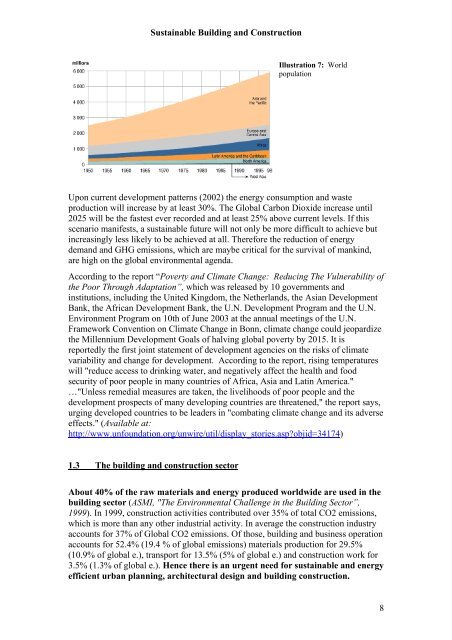Sustainable Building and Construction - International Environmental ...
Sustainable Building and Construction - International Environmental ...
Sustainable Building and Construction - International Environmental ...
You also want an ePaper? Increase the reach of your titles
YUMPU automatically turns print PDFs into web optimized ePapers that Google loves.
<strong>Sustainable</strong> <strong>Building</strong> <strong>and</strong> <strong>Construction</strong><br />
Illustration 7: World<br />
population<br />
Upon current development patterns (2002) the energy consumption <strong>and</strong> waste<br />
production will increase by at least 30%. The Global Carbon Dioxide increase until<br />
2025 will be the fastest ever recorded <strong>and</strong> at least 25% above current levels. If this<br />
scenario manifests, a sustainable future will not only be more difficult to achieve but<br />
increasingly less likely to be achieved at all. Therefore the reduction of energy<br />
dem<strong>and</strong> <strong>and</strong> GHG emissions, which are maybe critical for the survival of mankind,<br />
are high on the global environmental agenda.<br />
According to the report “Poverty <strong>and</strong> Climate Change: Reducing The Vulnerability of<br />
the Poor Through Adaptation”, which was released by 10 governments <strong>and</strong><br />
institutions, including the United Kingdom, the Netherl<strong>and</strong>s, the Asian Development<br />
Bank, the African Development Bank, the U.N. Development Program <strong>and</strong> the U.N.<br />
Environment Program on 10th of June 2003 at the annual meetings of the U.N.<br />
Framework Convention on Climate Change in Bonn, climate change could jeopardize<br />
the Millennium Development Goals of halving global poverty by 2015. It is<br />
reportedly the first joint statement of development agencies on the risks of climate<br />
variability <strong>and</strong> change for development. According to the report, rising temperatures<br />
will "reduce access to drinking water, <strong>and</strong> negatively affect the health <strong>and</strong> food<br />
security of poor people in many countries of Africa, Asia <strong>and</strong> Latin America."<br />
…"Unless remedial measures are taken, the livelihoods of poor people <strong>and</strong> the<br />
development prospects of many developing countries are threatened," the report says,<br />
urging developed countries to be leaders in "combating climate change <strong>and</strong> its adverse<br />
effects." (Available at:<br />
http://www.unfoundation.org/unwire/util/display_stories.asp?objid=34174)<br />
1.3 The building <strong>and</strong> construction sector<br />
About 40% of the raw materials <strong>and</strong> energy produced worldwide are used in the<br />
building sector (ASMI, "The <strong>Environmental</strong> Challenge in the <strong>Building</strong> Sector”,<br />
1999). In 1999, construction activities contributed over 35% of total CO2 emissions,<br />
which is more than any other industrial activity. In average the construction industry<br />
accounts for 37% of Global CO2 emissions. Of those, building <strong>and</strong> business operation<br />
accounts for 52.4% (19.4 % of global emissions) materials production for 29.5%<br />
(10.9% of global e.), transport for 13.5% (5% of global e.) <strong>and</strong> construction work for<br />
3.5% (1.3% of global e.). Hence there is an urgent need for sustainable <strong>and</strong> energy<br />
efficient urban planning, architectural design <strong>and</strong> building construction.<br />
8

















